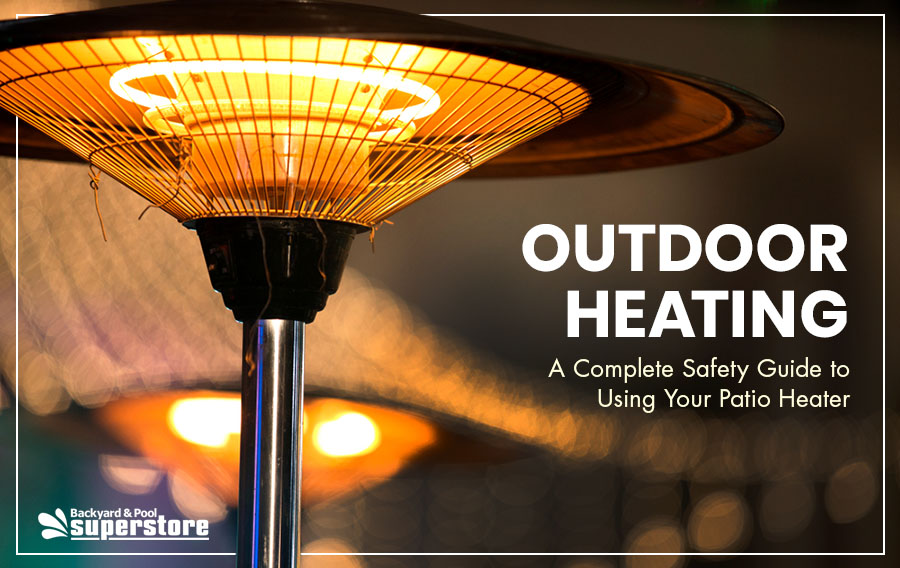
Patio heaters provide warmth and ambiance and enable you to enjoy your backyard year-round. However, to get the most out of your patio heater and avoid injury or damage, it is necessary to understand how to use your unit safely. With proper safety measures, you can enjoy a midmorning latte, twilight cocktailor a mug of steaming hot chocolate with friends and family on a chilly evening in your backyard.
The Right Patio Heater for the Right Space
To make sure your patio heater performs optimally, you must have the right type of patio heater for your outdoor space. There are a variety of styles to choose from, including the classic domed heaters that feature an umbrella-like reflector at the top, to pyramid-shaped heaters that contain the flame inside a glass tube or even compact tabletop patio heaters which are ideal for smaller outdoor spaces.
Each style of outdoor patio heater has its advantages and disadvantages in terms of portability and décor. However, the primary factor to consider when it comes to safety is the heat capacity and fuel efficiency of your patio heater.
The heat emitted by your patio heater is measured in British Thermal Units (BTUs). There is no exact way to calculate the right number of BTUs for your outdoor space; however, it is recommended that you select a unit that offers approximately 5,000 BTUs per 100 square feet.
Safety Features of Patio Heaters
Patio heaters have been designed with consumer safety in mind and offer a range of safety features to prevent fire hazards and accidental injuries. Before you buy a patio heater, check for the following features.
No Naked Flames
While restaurants and bars often have spectacular heaters with blazing flames on display, most patio heaters for home use have the flames safely contained inside tempered glass tubing or an emitter for protection. This reduces the fire risk associated with using a patio heater.
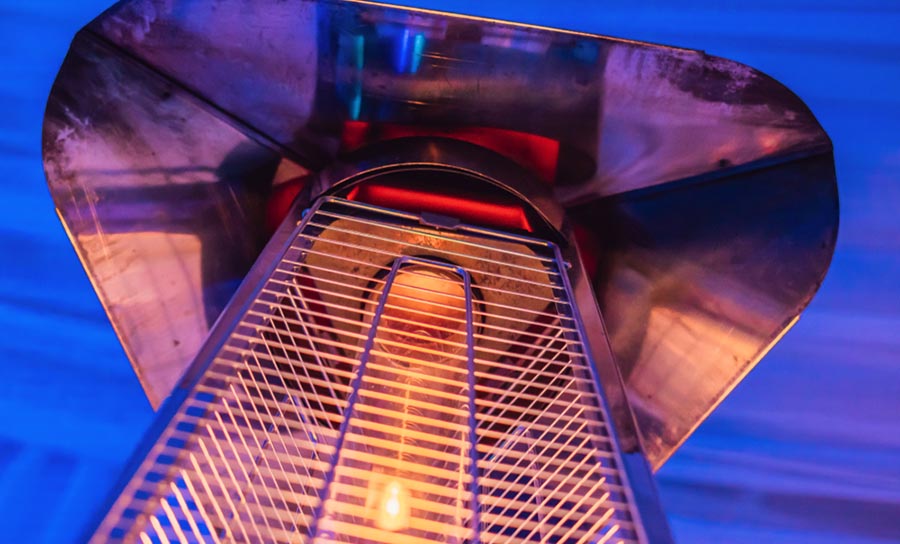
Anti-Tilt Device
Anti-tilt design features, such as a wide or weighted base, minimizes the risk of the heater toppling over. Higher-end models with more advanced features offer a switch that automatically closes off the burner as it senses the heaters falling.
Thermocouple
A thermocouple is a flame failure device that responds to changes in temperature and shuts off the gas valve if the flame goes out. This is an essential feature as it will prevent gas leaks if the flame is extinguished due to high winds.
CSA Safety Rating
A CSA safety rating is a seal of approval for the patio heater. The CSA safety rating means that the unit has been tested and approved by a third-party evaluator to meet a rigorous set of standards, and it has been deemed safe for use in North America.
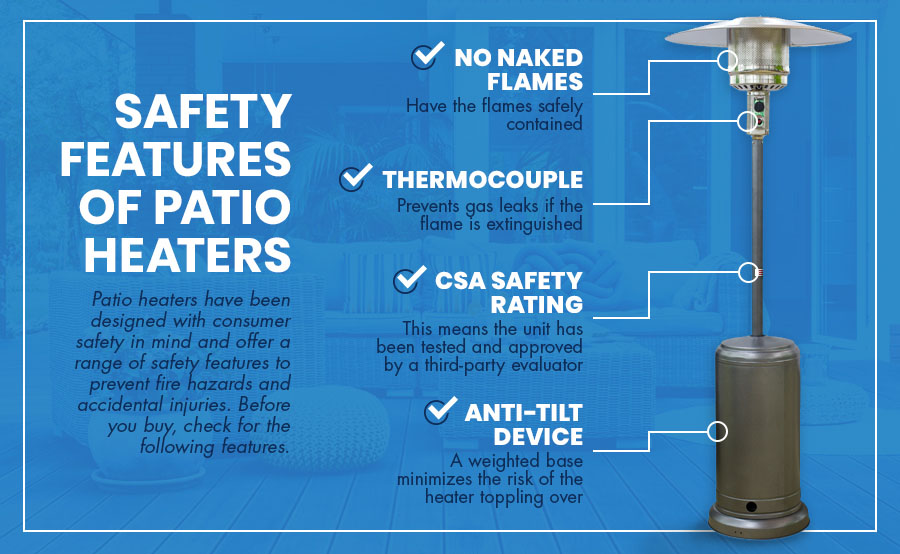
How to Safely Use Your Patio Heater
Once you have checked the safety features of your patio heater and selected a unit, there are a few factors to consider to ensure you use your patio heater safely.
Safe Placement
Patio heaters are not designed to radiate intense heat over long distances; instead, they heat nearby objects and people. If your heater is located too close to certain materials, it can become a fire hazard.
Keep patio heaters away from combustible materials. This includes planters and potted plants, outdoor textiles and grass, but it also includes flammable items such as propane tanks used for grills or lighter fluid.
The recommended distance away from combustibles is approximately three feet. This will ensure these flammable items and compounds are not exposed to high temperatures. However, always consult the manufacturer's directions in the instruction manual for your particular model as your patio heater may have additional features or structures necessitating alternative placement.
Safe Surroundings
Patio heaters are only suitable for use in outdoor areas, and care should be taken to ensure that your heater has adequate clearance and safe surroundings to prevent fire hazards.
Outdoor areas are defined as open or semi-open spaces and should have proper ventilation and air circulation to prevent carbon monoxide buildup, which is a by-product of combustion. Before placing your patio heater, check to see if your outdoor area is obstructed in any way by buildings or structures such as water tanks, which reduce the level of air flow.

Never place anything above or below your patio heater or check the manufacturer’s recommended inches of clearance, which varies according to the number of BTUs the heater radiates.
Also, never place your patio heater directly on grass, as this can make the unit unstable. If you plan to position the heater on your lawn, always place it on top of a solid, stable surface.
Fuel Safety
Patio heaters come in a variety of fuel types, all of which have benefits and drawbacks when it comes to operational safety.
Upright patio heaters typically come in two different fuel types: propane and natural gas. Due to the combustible nature of gas, you must take precautions when handling tanks and valves to minimize leaks and damage.
Propane-operated patio heaters are favored for their portability. To keep your propane tank safe and performing optimally, always close the gas tank valve when the patio heater is not in use as well as turning off the switch.
If you keep a spare tank, store it away from open flames and heated areas. After changing over gas tanks, check valves and hoses for leaks by applying soapy water to the components and checking for air bubbles.
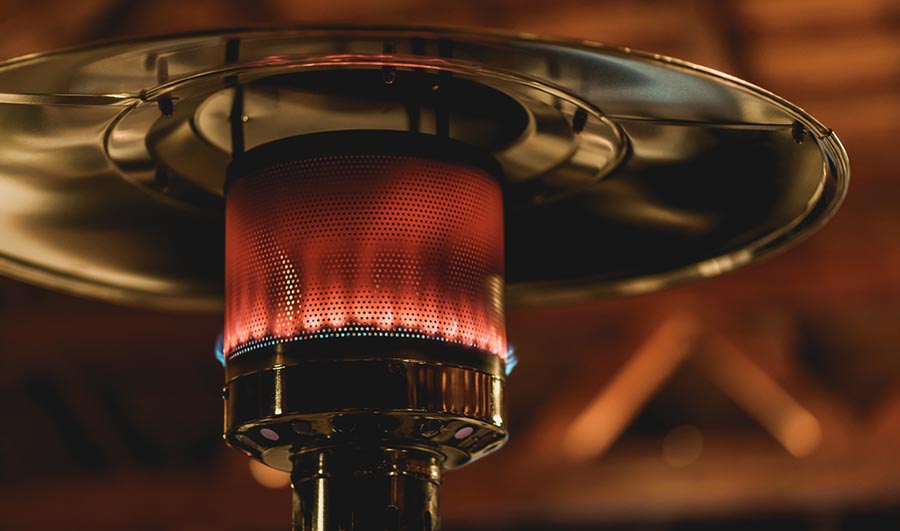
Patio heaters that use natural gas offer a more cost-effective alternative to heaters that use propane tanks, with many models also able to heat a larger area. However, it is essential that you have the heater connected to the natural gas line by a professional and always safely secure the unit to the ground using the included ground mounts.
Tilt Reduction
Patio heaters are constructed to be tall to disperse heat better; however, this can also make them top-heavy and put them at risk of tilting and toppling over. Even when the heater is turned off, residual heat from the reflectors or tubes can become a fire hazard if exposed to flammable material.
While some models of patio heaters feature anti-tilt devices that minimize the amount of movement, you should also take precautions to avoid knocking over your patio heater and try to secure and stabilize the heater where possible.
You can weigh down your patio heater with heat-resistant stabilizers such as sandbags or water weights to prevent movement. Alternatively, you can use flame-retardant ties such as bungee cords to peg your heater to the lawn as you would with a tent.
You could use a tabletop patio heater if you have a small or windy patio space as their more compact design offers more stability.
Weather Protection
Patio heaters are ideal for creating a warm, cozy outdoor environment during the colder months, and while most patio heaters have some weather-resistant coating, there is nothing more dangerous to a patio heater than wind.
Wind can easily knock over thin-bodied patio heaters, especially domed heaters, which act as an umbrella to catch the wind. You can protect your patio heater from the wind by anchoring it with weights or by placing it in a location that has less exposure.
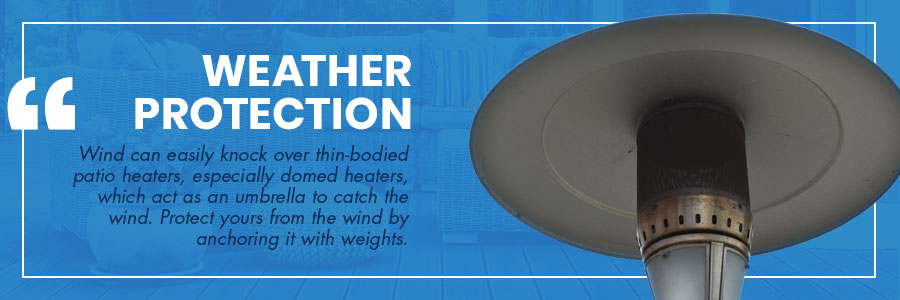
Wind also has a significant effect on the efficiency of your patio heater. The more your patio heater is exposed to wind, the more fuel it needs to use to achieve the same level of BTUs (the radiant heat measurement). So, to get the most out of your patio heater and avoid overworking it, keep it out of the wind as much as possible.
Portable Patio Heaters
A portable patio heater is an excellent addition to any outdoor area and gives your outdoor living area greater versatility by allowing you to entertain outdoors all-year-long. However, when moving portable patio heaters, it is crucial to take special care to avoid damaging your heater or injuring yourself.
Never move the patio heater while the flame is open. Moving a patio heater while open disturbs the flow of gas, and you risk damaging valves of hoses, which can expose leaked gas to the flame and create a fire hazard.
Avoid moving the patio heater on your own. Though most portable patio heaters have ergonomic features to improve portability, they are still cumbersome appliances. If you attempt to move the heater without the proper technique, you risk injuring your back.
Child Fire Safety Rules
Responsible adults in the household should operate patio heaters, and if there are children in the family, it is vital to establish fire safety rules and boundaries when it comes to patio heater operation.
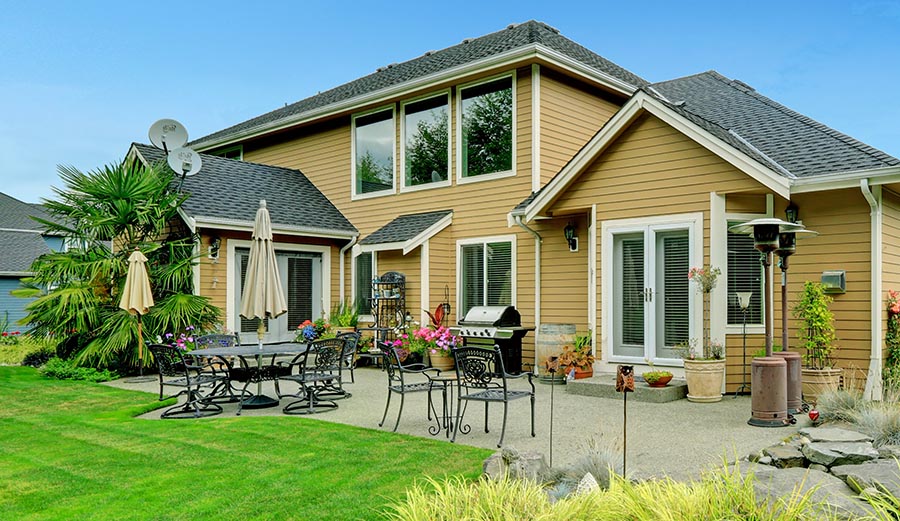
A good rule of thumb is that no one under the age of 15 should touch the patio heater, including switching it on or off and moving the heater. Do not allow young children near empty or replacement gas tanks as they could injure themselves and damage the tank if they drop it.
If your patio is a high traffic area for the kids or pets, ensure the patio heater is not in a space where it can be knocked over or accidentally touched during play. And never leave your patio heater running with children unattended.
Patio Heater Care and Maintenance
Just like any other home appliance, your patio heater requires regular care and maintenance to keep it working correctly and safely.
When a patio heater is covered in storage, it becomes a favorite hiding place for insects and can gather dust and debris, which can affect the pilot light and the burner. Dry storage areas can also cause rubber hosing to become brittle, and improperly stored heaters may be prone to rust and tarnishing. Taking a few steps before using your patio heater for the first time after storage will ensure that you have warmth and ambiance all season long.
Disassembly
To check for blockages or debris, dismantle the patio heater by disconnecting the gas line and removing the cover according to the manufacturer’s instructions. Typically, covers are attached with screws or nuts and bolts and removal is a simple process. At the back of the burner, there are usually two small silver tubes called venturi tubes. You can clean debris from these with pipe cleaners.
Cleaning
To clean your patio heater, use a mixture of soap and water and a non-abrasive scouring pad to clean the inside and outside of the emitter. You should avoid getting the burner wet and use a small amount of rubbing alcohol on a Q-tip or soft cloth to clean away built up grease or residue.
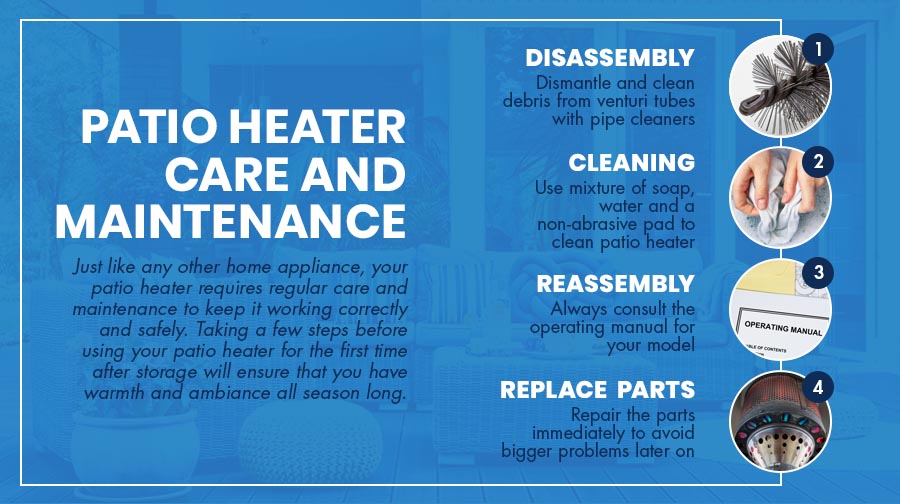
Reassembly
To reassemble your patio heater, reattach every component in reverse order. If you are uncertain or inexperienced with gas lines, it is safer to call a professional. And always consult the operating manual for your model of outdoor patio heater, as different types of heaters may require different disassembly, cleaning and maintenance instructions.
Replace Worn or Broken Parts
At Eka.Co Backyard Superstore, we carry patio heaters that are built to last, but like any appliance, improper use or accidental damage happens. If your outdoor patio heater is damaged or not performing optimally, replace or repair the parts immediately to avoid bigger problems later on.
Some parts that are at risk of damage include the pilot light, reflectors and emitters. During regular maintenance, check that all components are functioning correctly or call a technician to perform an assessment.
Final Word
A patio heater is a perfect addition to your outdoor entertaining area that enables you to host family and friends all year long–or even enjoy a winter spa day. But to keep your patio heater functioning properly and safely, follow these simple safety guidelines and maintenance tips.
 Hello Guest,
Hello Guest,  0 item(s)
0 item(s)
